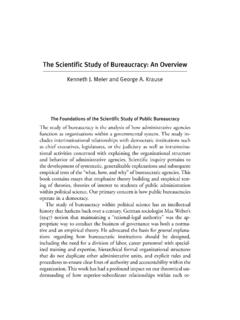Transcription of Analyses of Aggregate Fluctuations of Firm Networks Based ...
1 DP RIETI Discussion Paper Series 16-E-044. Analyses of Aggregate Fluctuations of firm Networks Based on the Self- organized criticality model and control theory INOUE Hiroyasu University of Hyogo The Research Institute of Economy, Trade and Industry RIETI Discussion Paper Series 16-E-044. March 2016. Analyses of Aggregate Fluctuations of firm Networks Based on the Self- organized criticality model and control theory 1. INOUE Hiroyasu Graduate School of Simulation Studies, University of Hyogo Abstract This study examines the difference in the size of avalanches among industries triggered by demand shocks, which can be rephrased by control of the economy or fiscal policy, and by using the production-inventory model and observed data. In addition, we investigate how differently demand shocks affect each firm by using control theory that utilizes network topology. We obtain the following results. (1) The size of avalanches follows power law. (2) The mean sizes of avalanches for industries are diverse, but their standard deviations highly overlap.
2 (3) We compare the simulation with an input-output table and with the actual policies and find them to be compatible. (4). The expectations about becoming involved in avalanches are diverse and depend on the industries. (5) It is difficult for service industries and small firms to be affected by the control . On the other hand, mining, manufacturing, and wholesale industries are strongly affected by the control . (6) If we clip a network in descending order of capital size, we do not lose the control effect. Keywords: Aggregate fluctuation , Demand, network , firm , Production, Inventory, control theory JEL classification: D22; H32; E32. RIETI Discussion Papers Series aims at widely disseminating research results in the form of professional papers, thereby stimulating lively discussion. The views expressed in the papers are solely those of the author(s), and neither represent those of the organization to which the author(s) belong(s) nor the Research Institute of Economy, Trade and Industry.
3 1. This study is conducted as a part of the project ``Price network and Dynamics of Small and Medium Enterprises''. undertaken at the Research Institute of Economy, Trade and Industry (RIETI). The authors thank the institute for various means of support. We thank Hiroshi Yoshikawa, Hideaki Aoyama, Hiroshi Iyetomi, Yuichi Ikeda, Yoshi Fujiwara, Wataru Soma, Yoshiyuki Arata, and members who attended the internal seminar of RIETI for their helpful comments. In addition, we thank Yang-Yu Liu for sharing his program codes and giving helpful comments. We gratefully acknowledge financial support from the Japan Society for the Promotion of Science (No. 15K01217). 1. 1 Introduction Giving stimulus to firms and prompting the spillover e ect is a way for a government to a ect its economy, which includes purchasing goods and services, giving grants to firms, and fine-tuning taxes. Governments consider fiscal policy as an important determinant of growth [1, 2]. Currently, analysis of input-output table is considered a strong tool to predict the spillover e ect [3].
4 It enables us to obtain a single predicted value of the spillover e ect caused by the stimulus. However, it is obvious that we cannot obtain the same result as that of the prediction, even if we use exactly the same volume as that used in the calculation. Nevertherless, we normally expect that the result should be substantially around the prediction. This concern, that, whether the expectation is correct is the main topic of this study. If the size of the spillover e ect is around the average of the prediction, it should be true that the propagation is never amplified or reduced through firm Networks . However, Gabaix showed that if the firm size distribution is fat-tailed, the hypothesis breaks down [4]. In addition, Acemoglu et al. pointed out that microeconomic shocks may lead to Aggregate Fluctuations in the presence of intersectoral input-output linkages [5]. These studies suggest that the stimulus and spillover e ect do not result in the proximity of the prediction.
5 In other words, normal distribution is usually assumed, but this assumption is doubtful. In addition, since the spillover e ect must be the stochastic process, it seems improbable that each firm has the same probability of receiving the spillover e ect. We can expect that the di erence comes from the structure of the network . Hence, we focus on the network topology for each firm , which is calculated by the controllability of the network . The controllability can be rephrased by the possibility of being involved in the shock propagation. This study reveals how demand shocks from outside cause the spillover e ect. We use a micro model invented by Bak et al. [6] and the control theory [7]. In addition, we employ observed data. We clear up the following points: (1) the diversity of the spillover e ect. (it must depend on industries in which shocks are given.); (2) the extent of getting involved in the spillover e ect. (it must also depend on industries.); (3) the topological possibility of firms getting involved in the spillover e ect; and (4) how we can clip a network without losing the e ect of the spillover e ect.
6 The remainder of this paper is organized as follows. In Section 2, we introduce the dataset. Section 3 describes the methodologies that we utilize in Analyses . Section 4 presents the results. Finally, Section 5 concludes. 2. 2 Data We use datasets, TSR Company Information Database and TSR Company Linkage Database, col- lected by Tokyo Shoko Research (TSR), one of the major corporate research companies in Japan. The datasets are provided by the Research Institute of Economy, Trade and Industry (RIETI). The TSR data contain a wide range of firm information. As necessary information for our study, we use identification, capital, industry type, suppliers and clients. We construct an entire network of firms Based on suppliers and clients. Note that there are up to 24 suppliers and up to 24 clients for each firm in the data. It may be considered that the constraint limits the number of links for each node. However, a node can be suppliers of other nodes without limitation, as long as those clients designate the node as a supplier, and vice versa.
7 Therefore, the numbers of suppliers or clients are not limited to 24. In particular, we use the dataset collected in 2012. The number of firms, that is, nodes, is 1,109,549. The number of supplier-client ties, that is, links, is 5,106,081. This network has direction and the direction is important in our study. We split firms Based on industries. The industries are classified by the Japan Standard Industrial Classification [8]. We mainly use the division levels that have 20 classifications. However, we make alterations to the classification. Since the classifications S: Government, except elsewhere classified . and T: Industries unable to classify are less important in our study, we omit them. In addition, we separate I: Whole sale and retail trade into wholesale and retail. The di erence of the divisions is not negligible in our study because shocks from outside, such as fiscal policies, often occur in retail. Therefore, the division level in our study after alterations shows 19 industries.
8 Moreover, we use three industries at the group level to compare the e ects of some Japanese fiscal policies. The groups are 5911: New motor vehicle stores, 5931: Electrical appliance stores, except secondhand goods, and 6821: Real estate agents and brokers. The di erence between the division and group levels is clear in the later industries and there is no concern about confusing the two levels. We use an input-output table to compare the prediction of the spillover-e ect size between a micro model and the table. As the closest table in time, we use the 2011 updated input-output table [9]. Figure 1 shows the degree distribution of the observed network . The red plots are the distribution of the observed network . An important point is that the distribution is fat-tailed, which means the distribution does not decay super-linearly. It seems that we can fit plots to a line P k , where P. 3. is the cumulative probability, k is the degree, and is a positive constant. If the degree distribution is the normal distribution, the plot is shaped as the blue plots in Figure 1.
9 Since normal distribution exponentially decays, we can observe the blue plots decrease super-linearly on the log-log plot. How to create the random network is explained in Section 4. The reason we should compare the observed network with the random network is that the random network creates Aggregate fluctuation that decays exponentially, as we show in Section 4. In other words, it tells us that if the random network is the network in the real economy, there is no fat-tailed Aggregate fluctuation . However, the observed network is not the random network as we see here. [Figure 1 here]. If a probability distribution or a cumulative probability distribution can be fitted to a line, it is said that the distribution is a power-law distribution. A network with a power-law distribution is often called a scale-free network . It has been pointed out that the power-law or scale-free nature of Networks is a determinant of fat-tailed Aggregate Fluctuations [4]. Since the observed network is the scale-free network , we expect that the Aggregate Fluctuations of the network are fat-tailed.
10 3 Methodology We use two methods. The first is a modified model [10] Based on a production model [6]. The modified model enables us to conduct micro-level simulations and investigate the characteristics of Aggregate Fluctuations . The second method is control theory [11, 12, 13, 7]. By using this theory , we can know which nodes are pivotal to invoke Aggregate Fluctuations in a network by given demand and which nodes are likely to be involved in Aggregate Fluctuations . model of production and inventory The model of production and inventory was originally invented by Bak et al. [6]. The model assumes that firms connect with each other on supply chains. Each firm has some amount of inventory. When a firm receives orders from clients, it supplies intermediate goods or services to clients. If the firm does not have enough inventory, it sends orders to suppliers. Therefore, cascades of orders and production sometimes occur. The size of the cascades can be defined by the total extent of production due to activated firms.







